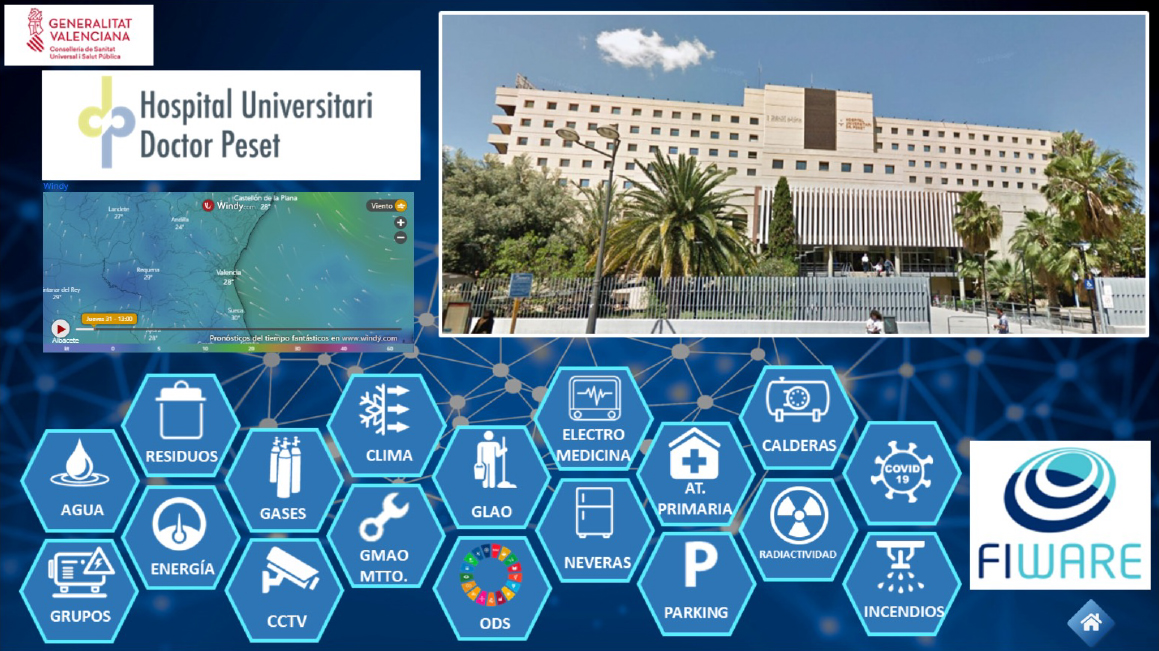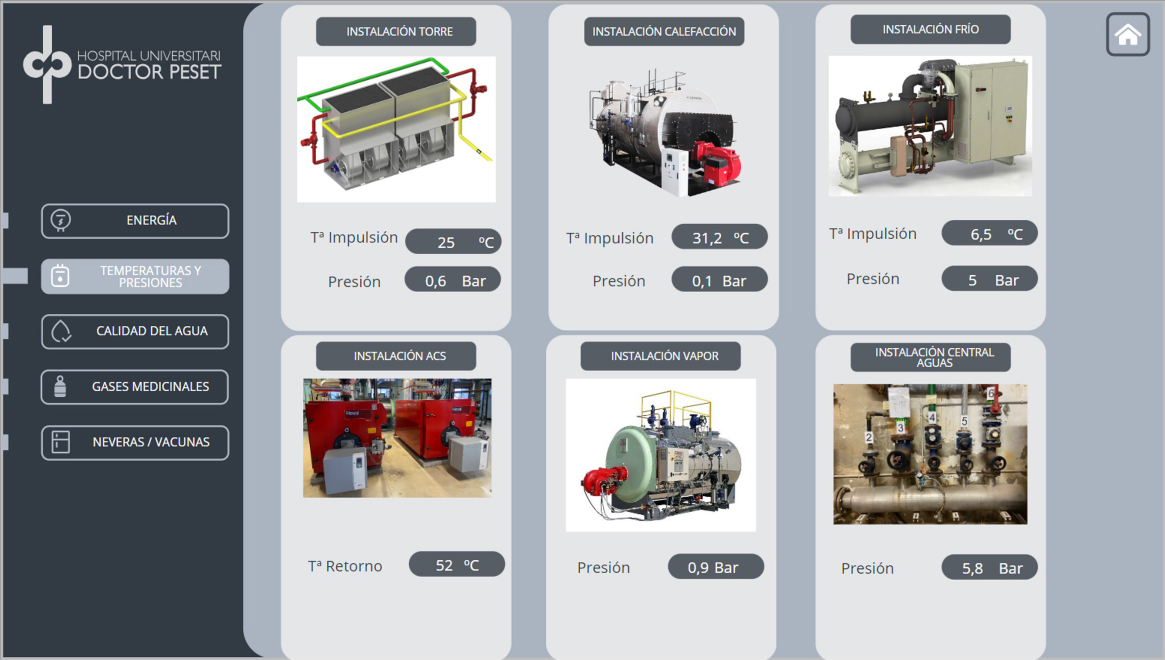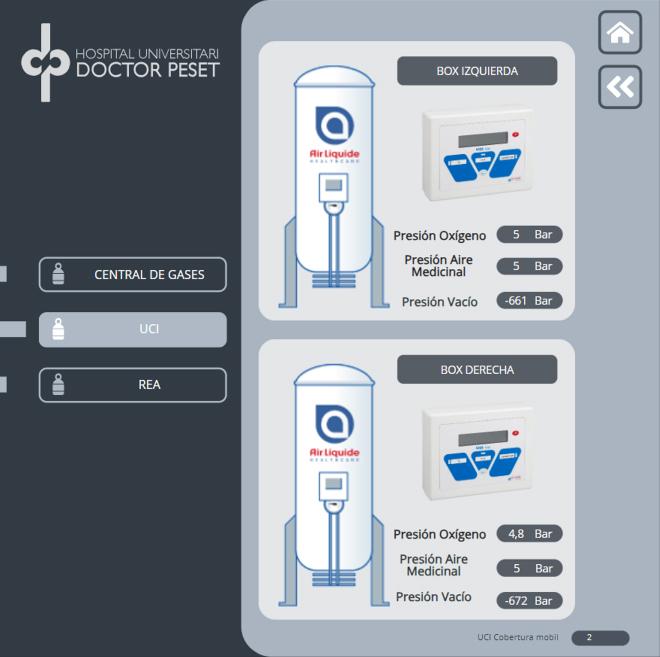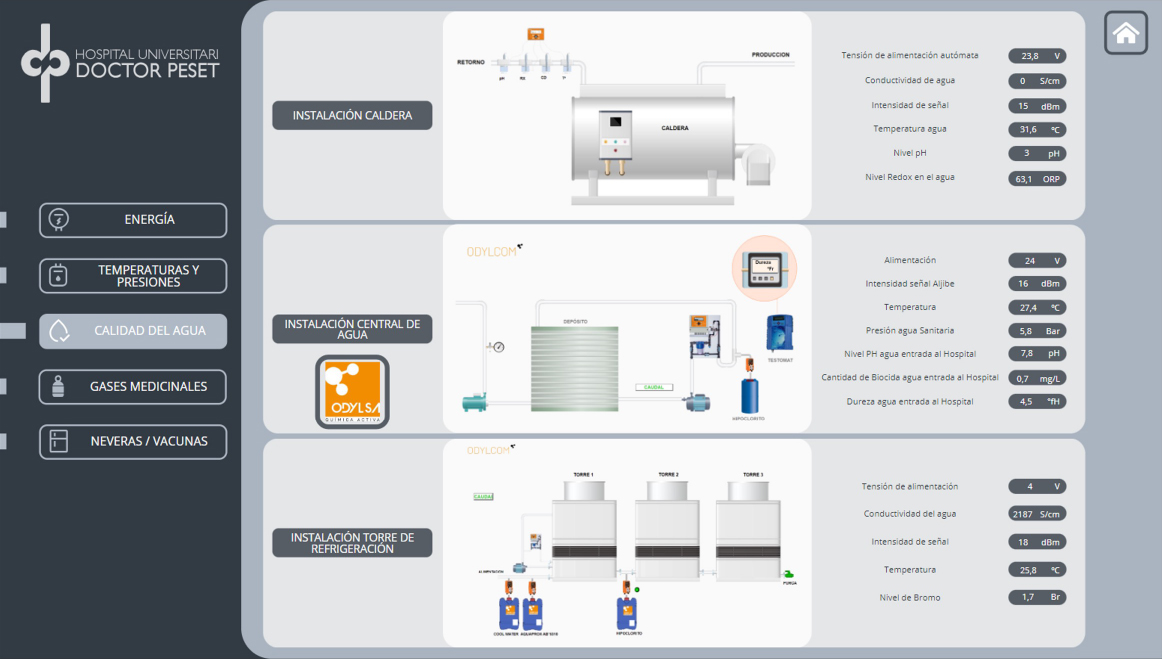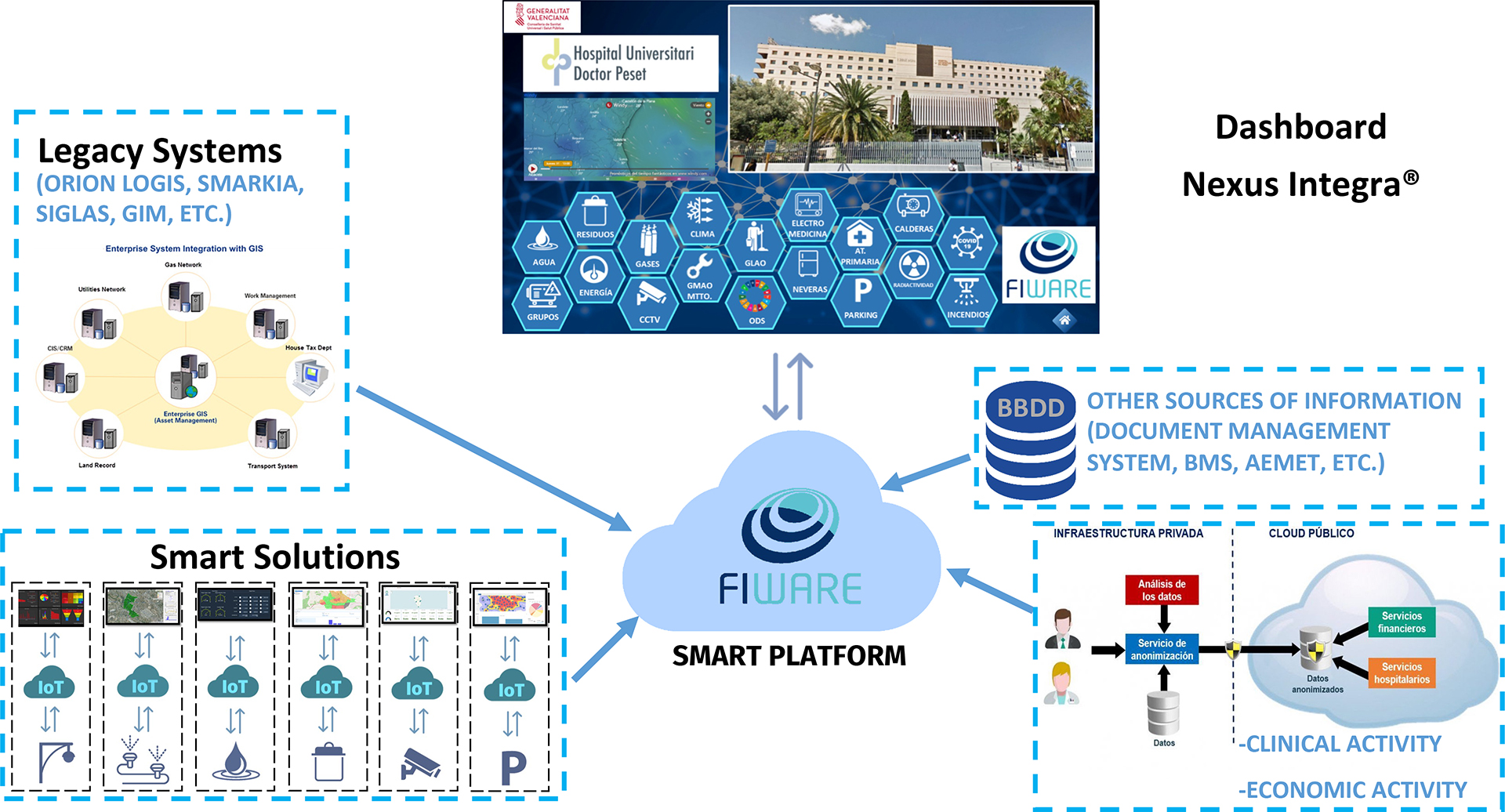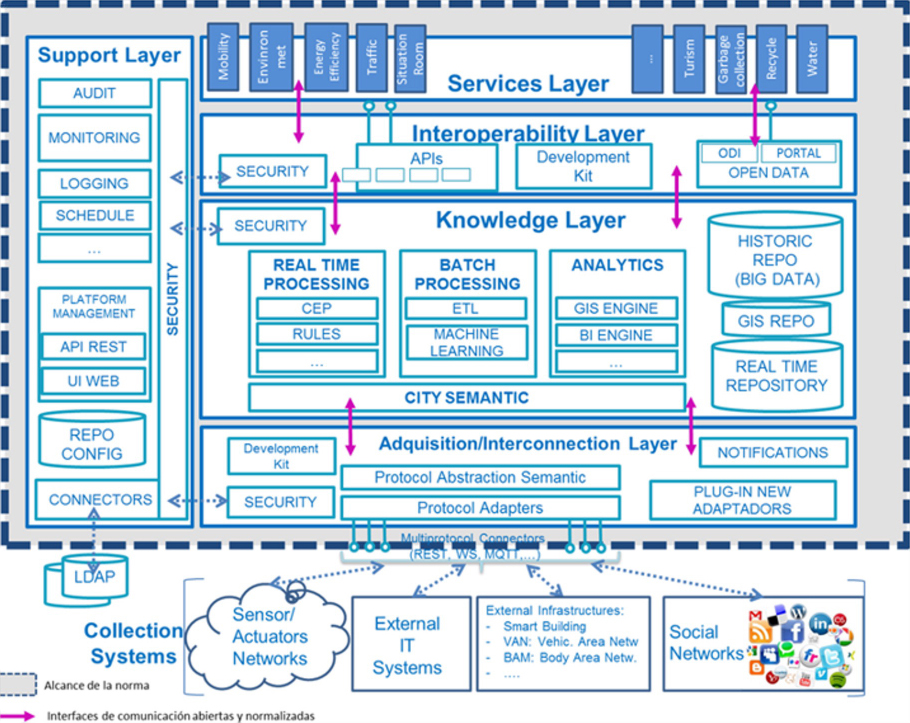Challenge & Context
Businesses have seen significant advancements due to the expansion of digitalization in machine and system intelligence. Therefore, it is essential for organisations to innovate on their processes in order to optimise their outcomes.
Digital transformation is a process that integrates digital technology into all aspects of a business or organisation. It is directly linked to key performance indicators (KPIs), making it a fundamental component of the business plan.
Digital transformation can be extrapolated to any sector, and in the following pages it is explained how the implementation of new technologies is revolutionising the healthcare sector.
Digital transformation is an essential tool to enhance the effectiveness of preventive action and healthcare, improve sustainability, and increase process efficiency.
Smart Hospital technology leverages data from operational technology (OT) and information technology (IT) systems to create intelligent environments that support the entire patient recovery process, as well as assist the centre’s management in improving oversight. This gives rise to the hospitals of the future, also known as Smart Hospitals.
To better understand this new concept, we must pause for a moment at the term smart city, which is a city that uses innovation and technology as tools for transformation and improving quality of life (while we know that there can be the most diverse definitions for smart cities).
In a smart city, sensors and Internet of Things (IoT) devices collect data on facilities, traffic systems, security, utilities, etc., which is then processed and sent to specific management platforms where it can be analysed and used to improve operations across the city.
In this context, the process of digitalization involves the integration of technology within buildings. Once the technology has been integrated, hospital centres can be monitored to regulate the performance and optimization of their resources, improve staff productivity, and enhance customer care.
For this reason, new technologies have become the foundation of healthcare digitalization, as they provide organisations with sustainable cost-saving options when implementing their IT infrastructures.
In this sector, it is becoming crucial to also focus on Artificial Intelligence (AI), primarily due to its capacity for deep and automated learning. This branch of AI, known as machine learning, can detect anomalies and predict potential failures through a diagnostic and analytical system. To achieve this, machine learning must work hand in hand with Big Data, as it requires massive amounts of data to implement predictive maintenance.
Some of the goals of digitalising the healthcare sector are providing customers with personalised and efficient assistance via monitoring of their systems, providing more interconnectivity among employees, and improving internal and external processes.
Solution
A global solution is proposed through the unification of these different applications and services in a single, centralised, operational environment in order to achieve a real Smart Hospital that is more sustainable, efficient, and resilient.
Figure 1 . Smart Hospital centralised operational environment: integration in different smart solutions, such as medical gases, water quality, vaccine refrigerator temperatures, energy consumption, etc.
Dr. Peset Hospital of Valencia has deployed its Smart Hospital platform based on high-quality data and the FIWARE Open Source approach and technologies, using the Context Broker as a central part of the platform. The Context Broker Generic Enabler is the core and mandatory component of any “Powered by FIWARE” platform or solution. Through a comprehensive operational environment oriented towards facility management, all information is digitised and centralised to better manage the operation of services and infrastructure in their Department of Health. All of this information is unified and stored in a structured manner in a database, and subsequently, an intelligent service layer will be generated to perform data correlation using advanced analytics techniques such as Big Data, machine learning, or AI.
Although there are already applications on the market oriented towards facility management in hospital administration, the innovative component of this solution is based on the FIWARE a standard open platform. This standard is aligned with UNE 178 and defines a horizontal, scalable, interoperable, open, and secure platform architecture, which are requirements that currently underpin intelligent ecosystems like Smart Cities, Smart Buildings, and Smart Tourist Destinations.
The aim is to immerse the hospital in continuous digital transformation, making it a national benchmark within the Smart Hospital ecosystem, using the same philosophy as many Smart Cities do today. With this initiative, the goal is not only to create a unique and centralised environment for monitoring all ancillary hospital services, such as medical gases, water quality, vaccine refrigerator temperatures, and energy consumption, but also, in the not-so-distant future, to visualise clinical services, which will improve patient health outcomes and create environments with new capabilities for professionals, and ensure continuous sustainable, economic, social, and environmental improvement.
Figure 2 . Smart Hospital centralised operational environment: integration of smart solutions, such as temperatures and pressures of the hospital infrastructure.
Figure 3 . Smart Hospital centralised operational environment: integration in different smart solutions, such as medical gases of the hospital infrastructure.
Figure 4 . Smart Hospital centralised operational environment: integration in different smart solutions, such as water quality of the hospital infrastructure.
The comprehensive operations platform of the intelligent Dr. Peset Hospital provides a fast and easy way to create a centralised operational environment to manage all geographically dispersed assets of an organisation.
The user can control, monitor, and navigate their facilities through a map. Within each of these facilities, there can be one or more layers of visualisation.
Dashboards
A centralised operational environment for analysing information and making decisions. The application enables the user to analyse continuous information flows to make decisions and plan upcoming actions. It also allows the user to oversee the production process from a single point through customizable dashboards. The application allows the creation of interactive and customizable company dashboards with cross-referenced information related to medical gases, water quality, vaccine refrigerator temperatures, energy consumption, and other ancillary hospital services.
Alarms
A centralised operational environment that notifies the user of any incidents throughout a process within the scope of facility management. A customizable alarm system that allows linking of all critical processes to a managed group of users so that they can be aware of any process operating outside the correct range of values. The Alarms application is a powerful tool that enables users to organise and categorise all defined alarm rules based on specified criteria.
Reports
A centralised operational environment to analyse and share historical data throughout the organisation. The Reports application enables users to analyse historical data both online and offline with MS Excel and PDF reports. Possibility to configure reports based on data ingested in the system with the purpose of standardising information and sharing it among users within the organisation.
Machine Learning App
The Machine Learning application harnesses specialised algorithms and artificial intelligence to provide advanced analysis for understanding process behaviours in an easy, intuitive, and scalable manner. This app manages different algorithms to make the best business decisions by comparing historical trends and real-time data.
Secure Web API
Enables the exchange of information between external applications and FIWARE. FIWARE provides a secure web API service that allows external applications to exchange information with the common data core of the platform. This bidirectional information flow can be used by these applications to feed their own systems, or by the comprehensive operations environment to add supplementary information, such as AI results or ML algorithms.
How it works
With the FIWARE Context Broker, visualisation tools, and other indicators, the solution covers the observation of contextual data through FIWARE-ready IoT devices, in addition to the integration of third-party data (different datasets) from legacy systems, Open Data, private data and other sources of information.
Figure 5 . Schema of the Hospital smart ecosystem based on FIWARE and IoT sensors for different Smart Solutions of the hospital ecosystem.
Figure 6 . Architecture of the smart hospital platform.
Monitoring Smart solutions IoT Devices
Smart Solutions are configurable IoT devices. They allow the monitoring of multiple variables, such as pressure, temperature/humidity, conductivity, pH, water hardness, electricity consumption, etc. Including all these sensors in a single device provides savings on installation, maintenance, management, and communication. It is offered in multiple versions, including NBIoT (Narrowband Internet of Things), Wi-Fi, LoRa/SigFox, and the LwM2M and MQTT protocols. These devices are a modular and cost-effective solution that is adaptable to specific needs, and supports reliable and high quality data for monitoring Smart Solutions, such as data about medical gases, water quality, vaccine refrigerator temperatures, energy consumption, etc. This is extensible with legacy systems and other relevant data sources that support data-driven and evidence-based decision-making.
Data Analysis/visualisation
The data visualisation service is based on the Nexus Integra® tool, which enables the configuration of alerts, data analysis, dashboard creation, multi-parameter monitoring/correlation, and integration/communication with the FIWARE platform via REST API. The data visualisation tool, based on the Nexus Integra® tool, promotes the effective use of open source resources by integrating datasets from utilities (energy/water) with the contextual monitoring from IoT sensors. As a result, the solution enables a contextual evidence driven tool for systematic data collection, e-health planning, and data analysis empowered by AI. This enables a higher understanding of the needs of cross-sector aspects, providing indicators and correlations/analysis to identify the best potential solutions to make the Smart Hospital more sustainable, efficient, and resilient.
Benefits & Impact
New technologies have brought about a turning point in the healthcare sector. The digital transformation of hospital centres is the new healthcare revolution, benefiting both patients and institutions significantly.
Benefits of Facility Management. The implementation of IoT sensors in hospital assets and facilities, connected to a centralised platform, enables management and control from an operations centre. This achieves energy efficiency and sustainability, alongside optimised organisation and process management. The proper use and implementation of artificial intelligence, the Internet of Things, and advanced analytics provide centralised control and efficient resource management, resulting in an improved patient experience and enhanced administrative effectiveness.
Added value through FIWARE
Dr. Peset Hospital has been able to leverage the potential of FIWARE Smart City platform components as an open source ecosystem based on European standards. Utilising enablers, such as the Context Broker and IoT agents has enabled the development of different solutions for Smart Hospital verticals.
This technological structure, which follows a common European standard, has significantly advanced the public administration market, promoting greater integration, openness, and standardisation. The Context Broker and FIWARE ecosystem have provided powerful open standard APIs for integrating and managing the contextual information from multiple data sources. To this respect, the FIWARE ecosystem has facilitated the Hospital’s implementation of scalable Smart Hospital services based on real-time and time series data, which is adapted to its needs and meets relevant standards.
Regarding technical specifications, the hospital has taken advantage of implementing solutions based on FIWARE and the Context Broker:
- Open source IoT platform: based on open source and developed by a large experienced community;
- Based on open standards: OMA NGSI and recognized as a standard established by the European Union (and beyond);
- Highly interoperable: FIWARE’s ecosystem has a positive impact on smart platforms’ interoperability;
- Homogenization and management of integrated data;
- Versatility in the creation of different applications based on a well-defined API and supported by a large number of use cases and services already available;
- Interoperability with the main IoT protocols available on the market (MQTT, LoRa, Ultralight, or OMA LwM2M);
- Data storage of generic databases: relational, non-relational, and indexed databases.
Next Steps
Due to the open and interoperable nature of this Smart Hospital platform, a standard could be created for all health departments of the Consellería de Sanitat of the Valencian government. In the future, this could enable centralised decision-making through the analysis of information and associated artificial intelligence tools. Standardising processes and being able to evaluate all generated information for treatment would help establish improvement measures on a technical, energy, organisational, etc., level.

